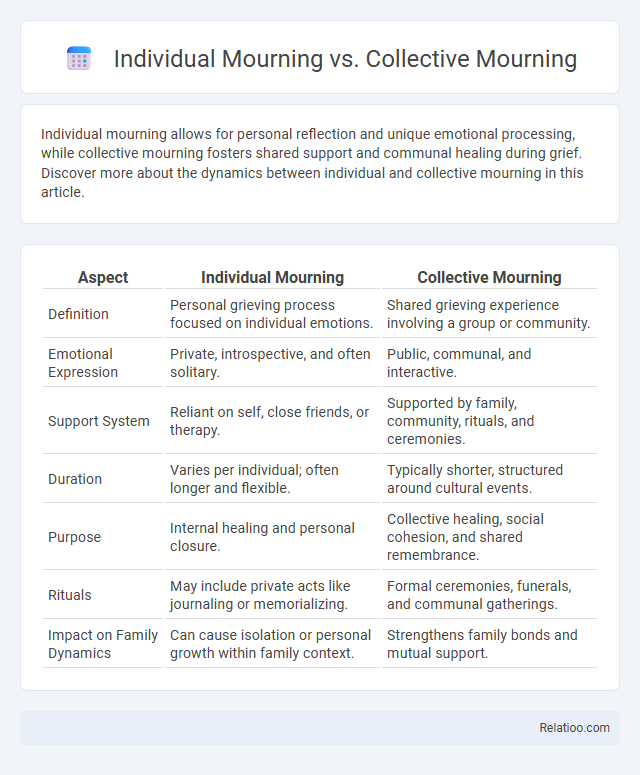Individual mourning allows for personal reflection and unique emotional processing, while collective mourning fosters shared support and communal healing during grief. Discover more about the dynamics between individual and collective mourning in this article.
Table of Comparison
| Aspect | Individual Mourning | Collective Mourning |
|---|---|---|
| Definition | Personal grieving process focused on individual emotions. | Shared grieving experience involving a group or community. |
| Emotional Expression | Private, introspective, and often solitary. | Public, communal, and interactive. |
| Support System | Reliant on self, close friends, or therapy. | Supported by family, community, rituals, and ceremonies. |
| Duration | Varies per individual; often longer and flexible. | Typically shorter, structured around cultural events. |
| Purpose | Internal healing and personal closure. | Collective healing, social cohesion, and shared remembrance. |
| Rituals | May include private acts like journaling or memorializing. | Formal ceremonies, funerals, and communal gatherings. |
| Impact on Family Dynamics | Can cause isolation or personal growth within family context. | Strengthens family bonds and mutual support. |
Understanding Individual Mourning
Individual mourning involves a personal and unique emotional process influenced by one's relationship with the deceased, cultural background, and coping mechanisms. Unlike collective mourning, which occurs within communities or groups to honor shared losses, individual mourning centers on your specific feelings and reflections during grief. Understanding individual mourning helps in recognizing personal healing patterns and seeking tailored support for emotional recovery.
The Dynamics of Collective Mourning
Collective mourning involves shared expressions of grief within a community, creating a powerful dynamic where individual pain is transformed through social solidarity and cultural rituals. The dynamics of collective mourning intensify emotional support, reinforce communal bonds, and facilitate a collective process of meaning-making around loss. Your participation in collective mourning can help validate personal sorrow while contributing to a larger narrative of healing and remembrance.
Emotional Processes: Solo vs Shared Grief
Individual mourning centers on personal emotional processes where grief is experienced privately, often leading to introspection and personalized coping strategies. Collective mourning involves shared emotional expressions within a community, facilitating communal support and reinforcing social bonds through rituals and public remembrance. Mourning as a broader concept encompasses both solo and shared grief processes, reflecting the diverse ways individuals and groups navigate loss and emotional healing.
Cultural Influences on Mourning Practices
Cultural influences shape individual mourning by dictating personalized rituals and expressions of grief, reflecting deeply held societal values and beliefs. Collective mourning, often observed in communal ceremonies or public memorials, reinforces social cohesion and shared identity through culturally specific practices. Your mourning process is influenced by these cultural norms, which determine how grief is publicly displayed, the duration of mourning periods, and acceptable emotional expressions.
Rituals in Individual and Collective Mourning
Individual mourning rituals often involve personal practices such as private prayers, journaling, or lighting candles, allowing the mourner to process grief internally. Collective mourning rituals, including public memorials, funerals, and cultural ceremonies, provide a shared space for communal expression of loss and support. These rituals foster social bonding and cultural continuity, highlighting the contrasting yet complementary roles of individual and collective mourning in grief management.
Psychological Benefits of Personal Grieving
Individual mourning allows for personalized emotional processing, facilitating self-reflection and tailored coping strategies that enhance psychological resilience. Collective mourning fosters a shared sense of support and belonging, reducing feelings of isolation through communal rituals and collective acknowledgment of loss. Mourning, whether personal or communal, plays a critical role in emotional regulation, helping individuals reconcile grief and restore psychological equilibrium.
The Power of Community in Collective Mourning
Collective mourning harnesses the power of community by uniting individuals around a shared loss, creating a supportive environment that promotes emotional healing and resilience. Unlike individual mourning, where grief is experienced privately, collective ceremonies and rituals foster a sense of belonging and collective memory, strengthening social bonds. This communal experience often accelerates recovery by validating emotions and providing communal solidarity that individual mourning may lack.
Challenges in Expressing Grief Privately and Publicly
Expressing grief privately during individual mourning often encounters challenges such as feelings of isolation, difficulty verbalizing emotions, and societal expectations to quickly "move on." Collective mourning, however, presents its own difficulties, including balancing personal sorrow with public rituals, managing diverse emotional responses within a group, and navigating social norms about appropriate expressions of grief. Mourning overall faces the universal challenge of reconciling internal emotional struggles with external social frameworks, affecting how individuals and communities cope with loss.
Social Media’s Role in Modern Mourning
Social media platforms transform individual mourning by enabling personal grief to receive communal support, blurring the lines between private sorrow and public expression. Collective mourning emerges as users worldwide share condolences, memorialize lives, and join virtual vigils, creating digital spaces for collective healing and social solidarity. This shift redefines mourning practices, making grief a shared, networked experience influenced by real-time interactions and global connectivity.
Finding Balance Between Personal and Collective Healing
Individual mourning allows you to process grief privately, reflecting on personal loss and emotional responses. Collective mourning fosters shared experiences, creating community support and solidarity that can amplify healing. Balancing personal reflection with communal rituals helps integrate individual pain into broader social healing, facilitating holistic recovery.

Infographic: Individual Mourning vs Collective Mourning
 relatioo.com
relatioo.com